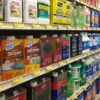Introduction
It might be surprising to learn that simply removing paint could be fatal, but the key ingredient in many paint-stripping products has felled dozens of people engaged in this run-of-the-mill task. In the waning days of the Obama administration, the U.S. Environmental Protection Agency proposed to largely ban paint strippers containing the chemical methylene chloride so they would no longer sit on store shelves, widely available for anyone to buy.
What’s happened since should be no shock to close observers of the Trump administration’s pattern of regulatory rollbacks. The EPA, after hearing from both Americans in support of a ban and companies opposed to it, pushed back its timeline for finishing the rule to an unspecified date, saying it needed more time to weigh the issue.
Consumer advocates fear the proposed rule has been effectively shelved, even as people continue to die while using methylene chloride paint strippers on bathtubs and other items — including at least three last year.
“There literally are bodies stacking up,” said Erik Olson, who directs the health program at the Natural Resources Defense Council, an environmental group. If the EPA won’t act on a chemical that’s undisputedly killing people, he said, “what are they going to act on?”
The NRDC is among the advocacy groups that plan to intensify their efforts to get these products off shelves another way — by ratcheting up pressure on home-improvement retailers such as Lowe’s and the Home Depot to stop selling them. Lowe’s said in an email to the Center for Public Integrity that it is working with suppliers on alternatives and is “committed” to nearly doubling the number of methylene chloride-free paint strippers it sells by the end of the year, to seven total.
A doctor who serves as a Maryland legislator, meanwhile, wants his state to institute the ban the EPA hasn’t finalized. And California regulators are working on a proposed rule that would require manufacturers to look for safer alternatives to methylene chloride in paint strippers. (Some such options already are on the market but don’t sell well, manufacturers say, because they don’t work as quickly.)
Even if these efforts bear fruit, they represent a patchwork approach that Congress seemed intent on avoiding when it amended the Toxic Substances Control Act in 2016. That legislation gave the EPA clear authority to ban chemicals presenting an “unreasonable risk” to health or the environment.
Often, chemical harms are hard to grasp because they’re not immediate. But methylene chloride, which research suggests carries risks of cancer and other long-term health problems, can also kill on the spot. It’s been linked to more than 50 deaths in the U.S. since 1980, a 2015 Center for Public Integrity investigation found — among them a few consumers and a wide variety of workers on the job. Teenagers. A mother of four. A 62-year-old man. An Iraq War veteran.
Using the product in enclosed areas, where fumes build up, puts people at risk of asphyxiation because methylene chloride is an anesthetic at high doses — knocking victims out and stopping them from breathing. Because it turns into carbon monoxide in the body, it can also trigger heart attacks in smokers and people with certain health conditions.
“It’s too toxic to use indoors,” said Dr. Robert Harrison, an occupational medicine physician at the University of California, San Francisco.
Over the decades, methylene chloride — also called dichloromethane — has struck down people removing paint or other coatings in bathrooms, tanks, basements, even in a church baptismal pool. The public appears mostly unaware of the danger. Clerks in hardware stores didn’t seem to know, a California agency found in a 2013 survey. But experts linked the chemical to deaths as far back as the 1940s. Criticism that the EPA hadn’t done something began in the 1970s, in the agency’s early years.
The European Union pulled methylene chloride paint strippers from general use in 2011. When the EPA proposed a rule in mid-January 2017, it wanted to ban sales to consumers and most other users.
The proposal was years in the making. It came over the sustained objections of paint-stripper manufacturers and their trade groups, which argued that job losses would follow. In 2016, after the EPA’s work on its proposed rule was well underway, the Halogenated Solvents Industry Alliance petitioned the U.S. Consumer Product Safety Commission to strengthen the products’ warning labels — then argued last year that this obviated the need for sales restrictions on the “most efficient and cost-effective paint remover products.”
“We certainly recognize that some people have been harmed when using methylene chloride without the appropriate safeguards, and we are committed to being a part of the solution,” Faye Graul, executive director of the alliance, said at a recent legislative hearing in Maryland.
The group, speaking on behalf of methylene chloride manufacturers and users, also said in comments on EPA’s proposed rule that the agency failed “to take into account the documented greater flammability risk posed by alternative products.”
Benzyl alcohol, recommended by some state agencies as a safer option for paint stripping, poses what the National Fire Protection Association calls a “fairly insignificant” fire hazard. The EPA noted in its proposal that methylene chloride is often mixed with flammable solvents in paint strippers on the market.
The EPA also considered whether better instructions would be enough to render methylene chloride safe. But dozens of studies “found that consumers and professionals do not consistently pay attention to labels for hazardous substances,” the agency said in its proposed rule, adding that proper safety precautions for methylene chloride are too complex for most users to successfully carry out.
In December, however, while trumpeting its deregulatory efforts, the EPA changed the categorization of its would-be ban from “Proposed Rule” to “Long-term Action.” The agency said in an emailed statement last week that officials “felt that more time was needed to consider how best to analyze and address any risks from these chemicals.”
In fact, the EPA has done that already — as part of its original proposal. Asked for an estimate on how long additional work on the rule would take and whether the agency still intended to finalize the proposal, the EPA did not respond.
Maryland Delegate Clarence Lam, a Johns Hopkins Bloomberg School of Public Health physician with a specialty in public and occupational health, saw the EPA’s handling of this chemical as a call to action. In February the Democrat sponsored a bill to ban methylene chloride paint strippers in his state. The legislation isn’t going anywhere this legislative session, but he’s hopeful about its chances next year.
“I didn’t think further risk assessments needed to be done,” Lam said. “This chemical probably should have been banned long ago.”
Industry representatives testifying against his bill argued that a ban would be premature because the EPA is on the job. They pointed not to the languishing proposed restrictions but to a separate toxics review the agency is undertaking. Methylene chloride is one of the targeted chemicals.
But relying on that effort to get action on paint strippers could delay restrictions for years because it’s an opportunity for the agency to retrace all the steps it already completed, said Liz Hitchcock, who heads Safer Chemicals, Healthy Families, a group that works to get toxic substances out of products.
“In the absence of EPA taking action, we are urging — and definitely increasing our efforts to persuade — the largest home-improvement retailers to take action on their own,” she said, and get “these dangerous products off their store shelves.”
Read more in Inequality, Opportunity and Poverty
Unequal Risk
Some paint strippers are killing people. The EPA promised to act — but hasn’t.
For now, the only ones yanking methylene chloride paint removers off the shelves are retailers.




Join the conversation
Show Comments